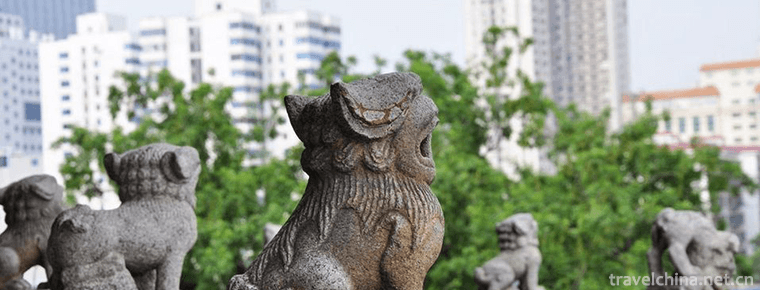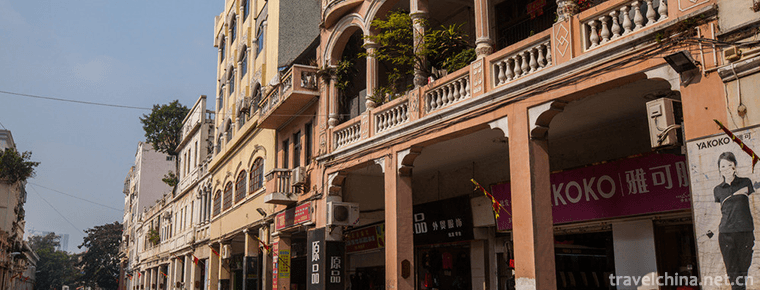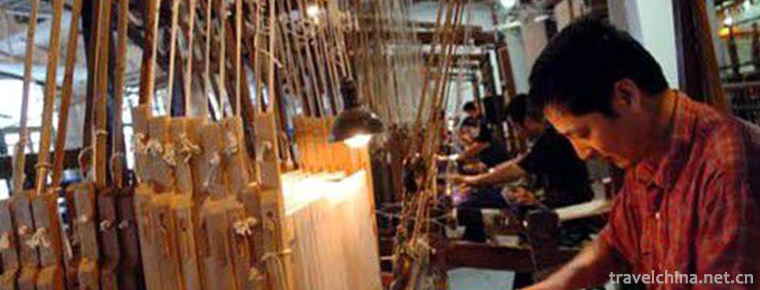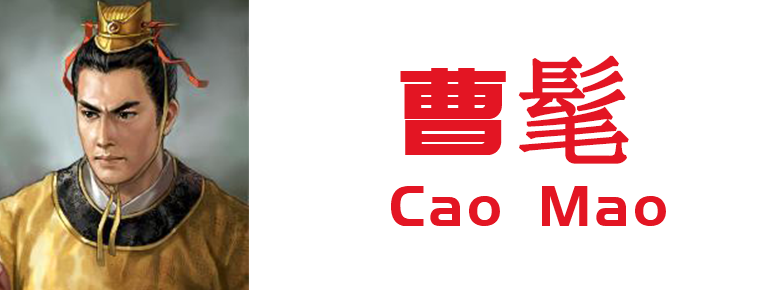Tianxin Pavilion
Tianxin Pavilion
Tianxin Pavilion is located in the southeast corner of Changsha City, Hunan Province. It is a tower on the ancient city wall of Changsha where Chengnan Road meets Tianxin Road.
Tianxin Pavilion has three floors of pavilion, building area 846 square meters, Biwa eaves, Zhuliang paintings.
Tianxin Pavilion was built at the end of Ming Dynasty, and was rebuilt during Qianlong reign of Qing Dynasty. During the Anti-Japanese War, Tianxin Pavilion was rebuilt in 1983 because of the burning of Wenxi fire.
historical origin
Tianxin Pavilion was built by Yang Xifu in the eleventh year of Qianlong (1746). The cabinet got its name from Shangshu, which means "Xian has a virtue and enjoys the heart of heaven".
The total floor area of the attic was 864 square meters, which was the highest point in the city at that time.
After liberation, the city government listed it as a cultural relic protection unit. The pavilion was rebuilt in 1983, with wooden-like structure, eaves of chestnut tiles, painted buildings of Zhuliang, three main and vice pavilions, and corridors between them. The whole cabinet is distributed in an arc shape.
The main cabinet is supported by 60 wooden pillars, with 32 tall peckers, 32 bronze bells and 10 kissing dragons.
There are 62 stone lions carved on the stone railings around the pavilion, as well as stone carvings of cars, horses, dragons, plums, bamboos and hibiscus, which reflect the features of Changsha Chuhan famous city. In addition, the cabinet also treasures many celebrity calligraphy and paintings.
The history of Tianxin, Changsha's city-building, began in the five years of Gaozu in the Western Han Dynasty. Liu Bang made Han Dynasty, and Wu Rui, a feudal minister, was king of Changsha. He set up Changsha, the capital city of Changsha, and began to build earthen cities.
From the Han Dynasty to the Song Dynasty, with the development of society, the city pools gradually expanded from north to south. By the Yuan Dynasty, the vastness had been fixed, but the shape of the city wall was still relatively crude. In the early Ming Dynasty, the base site was made of stone to make it "complete up and down". In the eleventh year of Shunzhi in the Qing Dynasty, Hong Chengchou demolished the Fancheng bricks of the Ming Dynasty's vassal palaces and used them to build the walls to make them thicker and thicker.
Since then, it has been built again, with pits, more grilles, and additional towers, fortresses and stacks. After 1911, in order to develop trade and transportation, demolish the city wall and build the road around the city, this section was saved because the cabinet stood at the head of the city.
Orion of the Name
Tianxin Pavilion, originally known as Tianxin Pavilion, originated from the popular saying of "Xingye" in the Ming Dynasty. According to the division of stars, Tianxin Pavilion is named for the "Changsha Star" in the sky. Therefore, this pavilion was once the place where the ancients observed stars and worshipped the gods of heaven. In addition, it was located on the top of Longfu Mountain in the ancient city of Changsha, and was regarded as a geomantic treasure with auspicious omens by the ancients. People are willing to pray here. Eliminate disasters and strengthen the family.
During the reign of Qianlong in Qing Dynasty, with the relocation of Chengnan Academy to Tianxin Pavilion, Tianxin Pavilion served as a cultural sacrificial site corresponding to Chengnan Academy. In the pavilion, two gods, Emperor Wenchang and Kuixing, were worshipped to ensure the prosperity of Changsha's culture and prosperity. In the old days, many worshippers visited the pavilion, and literati and ink poets often visited the pavilion and chanted poems.
Huang Zhaomei, a university student in Qing Dynasty, wrote a song "Everywhere Clouds and Mountains Come into View, All Fireworks Concern" which has become a masterpiece for thousands of years. However, Li Dongyang's excellent couplet of "Water, Land and Continent Boats, Boats Still Moving; Pigeons in Tianxin Pavilion, Pigeons Flying Pavilion Still Not Flying" in Ming Dynasty is still widely praised until 2018.
The ancient wall of His Excellency Tianxin was built in the fifth year of Gaozu in the Western Han Dynasty (202 B.C.). It was built by Wu Rui, the king of Changsha, with a history of more than 2200 years.
In the fifth year of Hongwu Ming Dynasty (1372 A.D.), Changsha commander Qiu Guang was restored and strengthened. The length of Qiu Guang was 8.5 kilometers. It was long in North and south, narrow in East and west. There were nine gates, which greatly enhanced the defensive capacity of Changsha City Pool.
From then on to 1924, the former National Government built the road around the city, retaining only the ancient wall of Tianxin Pavilion, which was 251 meters long and 13.4 meters high. It was very rare in the existing examples of urban defense fortifications in ancient China. It was of great value to study the defense of ancient military cities. It was a few cultural carriers and historical sites in the ancient city of Changsha.
characteristic
"Tianxin Pavilion" is said to have come from legend. At that time, astronomers believed that the terrain here was high and the vein of the earth was uplifted, which was the auspicious sign of the prosperity of the literary movement. Therefore, two pavilions of "Tianxin" and "Wenchang" were built in the city buildings to correspond. In the past, there were couplets: "All the clouds and mountains are in sight, and all the lights are always concerned about." That is the original intention of the cabinet. With the passage of time, Tianxin and Wenchang Pavilions were destroyed. Only a plaque of "Tianxin" remained, and a pavilion built next to Wenchang Pavilion site was called Tianxin Pavilion.
Because of its high terrain, Tianxin Pavilion has become a necessary base for soldiers in order to attack and defend dangerous areas. In the Taiping Heavenly Kingdom, the Xiwang Xiao Dynasty led the army to attack Changsha from here. By 2018, there were still some gunholes left on the wall. In 1905, Sun Yat-sen and Huang Xing sent Chen Jiading, members of the League in Japan, back to Hunan to organize the League organs, whose secret organs were once located in the Tianxin Cabinet. On July 27, 1930, Peng Dehuai led the Red Army of Workers and Peasants into Changsha, and also reported to the army at Tianxinge Pavilion. In 1938, when the Wenxi fire broke out in Changsha, Tianxin Pavilion became a shining tile.
There are also couplets about Tianxin Pavilion: Shuilu Continent, Zhou Zhouzhou, Zhouzhuozhou does not move. Tianxin Pavilion, Pavilion Pigeon, Pigeon Flying Pavilion does not fly.
Commentary: "Water and land continents, continental mooring boats, boats moving continents do not move", this linkage is relatively static, the artistic conception is far-reaching, three sentences, two "thimbles", "continents" and "boats" are homonyms.
In 2006, Tianxin Pavilion restored the building in front of the main building in the East and solicited old couplets publicly. An old man living in the provincial library provided a picture with clear couplets. According to textual research, the old building is called the Zhenlie Building Gate, which was built in the 1940s. It was built at the same time with the fierce pavilion that still exists in the Tianxin Park scenic spot. There are two pairs of couplets on the floor, one of which is "swallowing Hujian in breath, and bravely defending the mountains and rivers." On both sides, they say, "Forget death when you are in trouble. What you want is more than life."
Military importance
Because of its high terrain, Tianxin Pavilion has become a necessary base for soldiers in order to attack and defend dangerous areas. Tianxin Pavilion is located in a dangerous location.
There are two inner and outer cities, the outer city is divided into North and south two months city. There are eleven gun holes in the outer city. According to Tongzhi four years record, the city wall was thirty-three meters high at that time, and the Gage was forty-eight meters high, which was an important military defense fortress in ancient times. The remaining wall is 251 meters long and 13.4 meters high. Tianxin Pavilion has experienced war and has been destroyed and rebuilt repeatedly. In 1852, Xiao Dynasty, the Western King of the Taiping Army, led an attack on Changsha and fought with the Qing Army. He was killed in Heaven's Heart.
Burning and reconstruction
In 1938, "Wenxi Fire", the ancient city of Changsha, a scorched soil, attic is nonexistent, only the solid wall of the Ming and Qing Dynasties (kiln seal as proof) crying silently. Tianxin Pavilion was rebuilt in 1984. The pavilion has the style of the towers of Ming and Qing Dynasties. The Pavilion is connected by veranda, which looks like the ups and downs of hills, scattered and magnificent. Its structure is made up of lifting beams, without arch, three-storey pavilions supported by 46 red lacquer cylinders, combined with galleries and pillars, chestnut tile powder walls, gray-white stone foundations, thick and solid, 62 stone lions with different postures, 32 dragons with wingspan, blue sky, 32 Wind Horse bells ringing in the wind, giant kissing dragons with their respective leaders. Stone wall pattern, but also worshipped by the ancients totem, hunting and chariot horse, looks like it is still flag hunting, horse Xiaoxiao. The whole building is solemn and vigorous in tone, simple in style, a historical painting and a classical poem. The ancient pavilion is magnificent, the weather is magnificent, visitors come, look north at the Xiangliu River, invite Yue Se to the south, look at the motherland, remember the revolutionary martyrs, and revitalize the aspiration of China, all of which arise spontaneously.
Traffic information
Take bus 122, 130, 167, 171, 311, 314, 402, 406, 803, 908 in the urban area and get off at Tianxinge stop, or take bus No. 2, 143, 145, 358, 803, 804, 901 at Tianxinge West Gate stop.
Tianxin Pavilion
Tengwang Pavilion (Nanchang City), Yueyang Pavilion (Yueyang City), Yellow Crane Pavilion (Wuhan City), Stork Pavilion (Yongji City, Shanxi Province), Penglaige Pavilion (Penglai City, Shandong Province), Grand View Building (Kunming City), Yuejiang Pavilion (Nanjing City), Tianxin Pavilion (Changsha City), Zhonggu Pavilion (Xi'an City), Tianyi Pavilion (Ningbo City) and other ten famous Chinese historical and cultural buildings will be jointly declared. National material and cultural heritage.
Pictures From:
http://bbs.fengniao.com/forum/2254687.html
http://bbs.fengniao.com/forum/1385743.html







-
Sweet potato porridge
Main ingredients for food ingredients: 250 grams of fresh sweet potato, 150 grams of Japonica rice, a number of red dates, and a proper amount of sesame seeds.
Views: 286 Time 2018-11-02 -
Xianguding Scenic Spot
Xianguding, located in the south of Huancui District, Weihai City, is only five kilometers away from the city centre. It is the highest peak in the Northwest Mountain of Wangdao, with an elevation of .
Views: 117 Time 2018-12-22 -
Nanning Zoo
Nanning Zoo, located at 73 East University Road, Nanning City, was built in 1973. It was officially opened to the outside world in 1975 with a total area of 39.1 hectares. It receives more than 1 mill.
Views: 172 Time 2018-12-27 -
Jinshuitai Hot Spring Scenic Area
Jinshuitai Hot Spring is a hot spring resort built according to the national AAAA scenic standard. It is located in Shuitai Town, Xinxing County, Guangdong Province.
Views: 375 Time 2019-01-27 -
Haikou Arcade Street
The old arcade street in Haikou is one of the most distinctive Street landscapes in Haikou. Four of the oldest buildings were built in the Southern Song Dynasty.
Views: 231 Time 2019-02-07 -
Shandong Zhisheng Tangquan Tourist Resort
Shandong Zhisheng Tangquan Tourist Resort is located in Linyi City, Shandong Province. It is invested and constructed by Shandong Chenshi Home Estate Co., Ltd..
Views: 420 Time 2019-02-08 -
Handmade Weaving Techniques of Wood Machine Cosmetics
Nanjing Yunjin wooden machine makeup and hand-weaving skills, the local traditional skills of Nanjing, Jiangsu Province, one of the national intangible cultural heritage..
Views: 129 Time 2019-06-07 -
Western Qin Opera
Western Qin opera, also known as "chaotic play", is popular in Haifeng, Lufeng, Chaoshan, southern Fujian and Taiwan. Western Qin Opera flowed into Hailufeng in the northwest of the Ming Dyn.
Views: 115 Time 2019-07-01 -
Cao Mao
Cao Mao (241 November 15th - 260 June 2nd) Zi Yan, Pei County, Yuzhou City. Anhui Province Bozhou City People, the Three Kingdoms period the Wei state of the Three-Kingdoms Period The fourth emperors .
Views: 242 Time 2019-09-15 -
The first bay of the Yellow River
The first bay of Jiuqu Yellow River is located in Tangke Town, Zoige County, Aba Tibetan and Qiang Autonomous Prefecture, Sichuan Province. It is the junction of Sichuan, Qinghai and Gansu provinces..
Views: 140 Time 2020-11-07 -
History of Deyang
In ancient times, it was a place of hundred PU. In the fifth year of King Shenliang of Zhou Dynasty (316 BC), that is, in the ninth year of gengyuan, King Huiwen of Qin Dynasty, Qin destroyed the two states of Bashu and established two prefectures of Bashu. Today, Deyang Prefecture belongs to Shu Prefecture. County under the county, County Pavilion..
Views: 122 Time 2020-12-14 -
Guangyuan transportation
Guangyuan has been the transportation hub and material distribution center in the adjacent areas of Sichuan, Shaanxi and Gansu since ancient times. The reconstructed Guangyuan new railway station includes Baoji Chengdu double track railway and .
Views: 79 Time 2020-12-15









